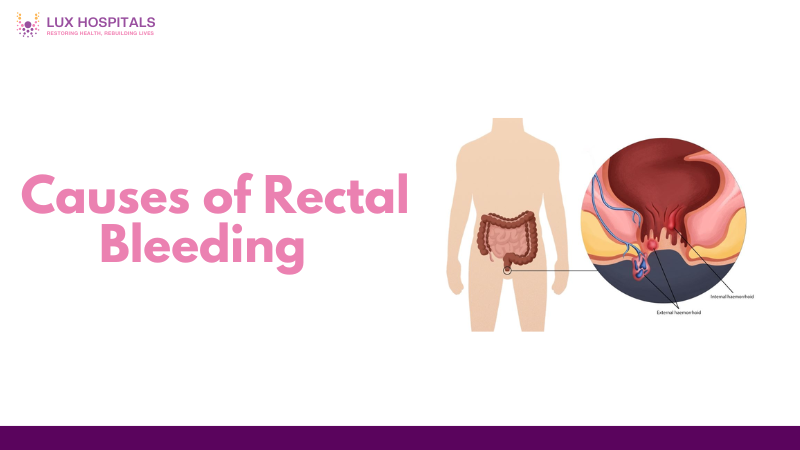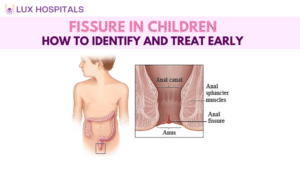What Causes Rectal Bleeding and How Is It Treated?

The severity of rectal bleeding can vary. And may result from various underlying health issues. Some causes are harmless, while others can signal more serious problems. This post will examine the top ten typical causes of rectal bleeding, the symptoms to watch for, and how each condition is treated.
What Is Rectal Bleeding?
Rectal bleeding refers to any blood that passes from your anus, often during or after a bowel movement. It may range in color from bright red to dark maroon or even black, depending on the source and cause of the bleeding.
Complications That Can Arise from Ignoring Bleeding
1. Hemorrhoids
Hemorrhoids are the most frequent among common cause of rectal bleeding. They appear when the veins around the lower rectum or anus become swollen or inflamed due to straining during bowel movements, pregnancy, or chronic constipation. Symptoms include itching, pain, and bright red blood after passing stool.
Treatment:
Mild cases can be treated with high-fiber diets, stool softeners, and warm sitz baths. Over-the-counter creams reduce itching and swelling. Surgical removal or rubber band ligation may be necessary in persistent or severe cases.
2. Anal Fissures
Anal fissures are tiny skin tears. Around the anus, often caused by hard stools or excessive straining. They are a painful but fairly common cause of bleeding, especially in infants and young adults. You may notice sharp pain during or after bowel movements and bright red blood on the toilet paper.
Treatment:
Increasing fiber intake and staying hydrated help soften stools. Warm baths and topical ointments with lidocaine or hydrocortisone promote healing. Chronic fissures may require Botox injections or minor surgery to relax the sphincter muscle.
3. Diverticulosis
Small, protruding pouches are a symptom of diverticulosis (diverticula) in the colon wall, typically in older adults. When these pouches bleed, it can result in painless but significant rectal bleeding. It’s one of the lesser-known but serious common causes of rectal bleeding.
Treatment:
Mild bleeding often stops on its own. A high-fiber diet helps prevent recurrence. If bleeding continues, a colonoscopy may be used to locate and treat the bleeding site, and surgery may be considered in severe or recurrent cases.
4. Colorectal Polyps
Unusual growths in the colon’s lining are called polyps in the colon or rectum. Although benign at first, some polyps can turn cancerous. Bleeding may occur if they become irritated or large. Polyps are often detected during routine colonoscopies.
Treatment:
All polyps found during colonoscopy are usually removed and sent for biopsy. Depending on the number and type, your doctor may recommend more frequent screening to monitor for recurrence or signs of colorectal cancer.
5. Colorectal Cancer
One of the most common forms of cancer is colorectal cancer, and harmful causes of rectal bleeding. Lethargy, blood in the stool, inexplicable weight loss, or a persistent change in bowel habits are some of its symptoms. Often, darker bleeding is mixed in with the stool.
Treatment:
The key is early detection. Depending on the stage, treatment options include chemotherapy, radiation, surgery, or targeted therapy. Routine screening after age 45 is essential for better results and early diagnosis.
6. Inflammatory Bowel Disease (IBD)
IBD encompasses disorders that result in persistent inflammation of the digestive system, including ulcerative colitis and Crohn’s disease. IBD. These ailments include diarrhea, stomach pain, weight loss, and rectal bleeding.
Treatment:
Immunosuppressants, corticosteroids, and anti-inflammatory drugs are commonly used. Stress reduction and dietary changes are also helpful in controlling flare-ups. In severe cases, surgery to remove damaged intestinal segments may be required.
7. Gastroenteritis
Infections that cause acute gastroenteritis can irritate the intestines and result in blood. This is more common in bacterial illnesses brought on by E. coli or Shigella. Other symptoms include diarrhea, vomiting, and cramping.
Treatment:
Most viral cases resolve with hydration and rest. If a bacterial cause is identified, antibiotics may be prescribed. Food safety procedures and good hygiene are crucial to stop recurrence.
8. Proctitis
Proctitis is an infection of the rectum’s lining that can result from infections, IBD, or radiation therapy. Symptoms include pain, a constant urge to have a bowel movement, and bloody stool.
Treatment:
Treatment depends on the cause. Antibiotics or antivirals treat infectious proctitis. For IBD-related cases, anti-inflammatory drugs and suppositories could be applied. For long-lasting relief, the underlying issue must be addressed.
9. Angiodysplasia
This condition involves the colon’s fragile, enlarged blood vessels, typically in older adults. It’s one of the more silent common causes of rectal bleeding and may cause intermittent, painless bleeding.
Treatment:
Endoscopic methods, such as laser treatment or cauterization, stop the bleeding. Blood transfusions or iron supplements might be required for patients with chronic anemia. Surgery is a possibility, but it is rare.
10. Rectal Ulcers
Rectal ulcers can result from prolonged straining, chronic constipation, or rectal prolapse. They may cause rectal bleeding, mucus discharge, and a feeling of incomplete evacuation.
Treatment:
Softening stools with fiber and fluids is essential. Surgery can be required to address underlying problems. Like prolapse. Topical medications and enemas can help promote ulcer healing.
Preventing Common Causes of Rectal Bleeding
You can prevent many common causes of rectal bleeding by following a healthy routine:
- Eat fibre-rich foods like fruits, vegetables, and whole grains
- Drink plenty of water daily
- Avoid excessive straining during bowel movements
- Exercise regularly to support digestive health
- Get regular colon screenings, especially after age 45
When to See a Doctor?
Not all rectal bleeding is dangerous, but it should never be ignored. Contact your doctor if you experience:
- Heavy or persistent bleeding
- Black or tarry stools
- Accompanied by symptoms like dizziness, weight loss, or fatigue
- Family history of colon cancer or IBD
Conclusion
Understanding the top common causes of rectal bleeding helps you make informed health decisions. While some cases are easily managed at home, others require medical evaluation. Avoid recurring or heavy bleeding early diagnosis often leads to better outcomes. Maintain a fiber-rich diet, stay hydrated, and attend regular screenings to support colon health. By being proactive and recognizing early warning signs, you can prevent complications and improve long-term digestive wellness. Timely medical care can distinguish between minor issues and serious diseases like colorectal cancer
Frequently Asked Questions
Hemorrhoids are the most common cause. They often lead to bright red blood during or after a bowel movement due to swollen veins in the anal area. It’s usually painless, although external hemorrhoids may cause discomfort or itching.
Yes, in many cases, like hemorrhoids or anal fissures, rectal bleeding is minor and temporary. However, it’s best to rule out more serious causes. If bleeding is light, doesn’t recur, and occurs after straining, it may not be serious.
To determine the cause and severity of the bleeding, they may use a physical exam, stool tests, colonoscopy, or sigmoidoscopy. A digital rectal exam is often the first step in evaluation. Imaging or endoscopy may be required for persistent or unclear bleeding sources.
No, but rectal bleeding can be one of its early signs, especially if accompanied by changes in stool shape, weight loss, or fatigue. Sometimes, the blood is not visible and is only be detected by stool tests.
Bleeding is usually bright red and may be seen on toilet paper or in the toilet bowl, often without being mixed with stool. This indicates bleeding from a lower rectal source, like hemorrhoids. Dark or black stools usually suggest bleeding higher in the digestive tract.




















